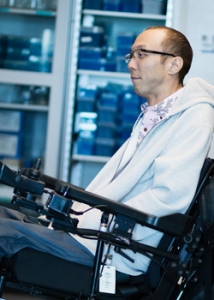No institution has perfected how to accommodate people with disabilities, but the triumph of one researcher at the University of Hawaiʻi at Mānoa John A. Burns School of Medicine (JABSOM) is a model of what is possible when institutions, faculty and a very special student unite. Jonathan Yap is making advances in science diversity as both a Native Hawaiian and quadriplegic scientist at the UH medical school.

As a young child growing up in Wahiawā, Yap had always been intrigued by his science classes. However, a bodysurfing accident at Sandy Beach Park seemed to end his research career prospects. As a high school student, Yap lost the use of his limbs and manual dexterity.
“After getting hurt, in many ways I felt lost—it was confusing and frustrating trying to define how I would be able to have a journey that leads me to where I ultimately would like to be,” said Yap.
Nevertheless, he soldiered on and continued to follow his passion for science to UH Mānoa where he earned not one but three degrees—a bachelor’s in biology, a master’s in physiology and most recently in May 2019, a PhD in cell and molecular biology.
“I’d always known that JABSOM is a quality institution,” Yap said. “I found the faculty to be consistently encouraging and eager to assist in the pursuit of my career goals.”
Nationally, there are few disabled individuals who have earned a doctorate in the biomedical sciences. As a graduate student, Yap won national-level funding for his career development and pursuit of his science, challenging institutes at the National Institutes of Health to accommodate funding for technical assistance to be his “hands” in the lab. Much of the additional federal support was matched by the Hawaiʻi State Government, and none of it would have been possible without JABSOM faculty advocating for these accommodations on his behalf.
“Because of my complete reliance on my technicians to perform the manual requirements of experiments, I’ve developed a special bond with each of them that I value to this day,” Yap said about technicians Monica Montgomery, Whitney Regan, Jan Garo, Jason Irei and Max Bishop.
As he continues his research at JABSOM, Yap hopes to leave a mark in the scientific world and to inspire others like him.
“I really hope to contribute in the sense of diversity as I recognize that there aren’t very many disabled individuals that are represented in this field,” he said. “I understand that it’s largely a function of the field, itself, being inherently hands-on that presents a number of challenges and I think the process of understanding and navigating those challenges has been quite a formative experience in my own life.”
—By Deborah Manog Dimaya

